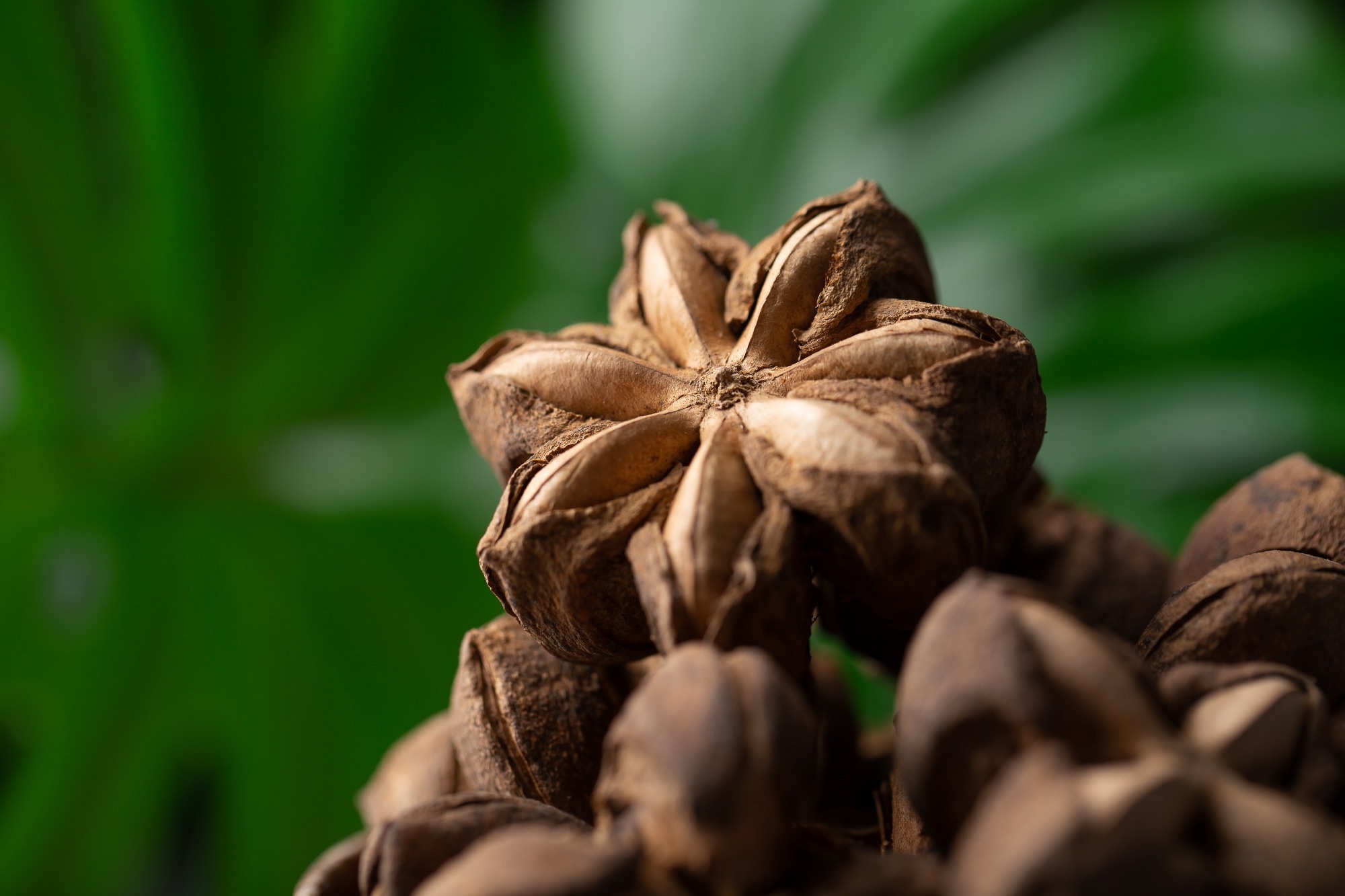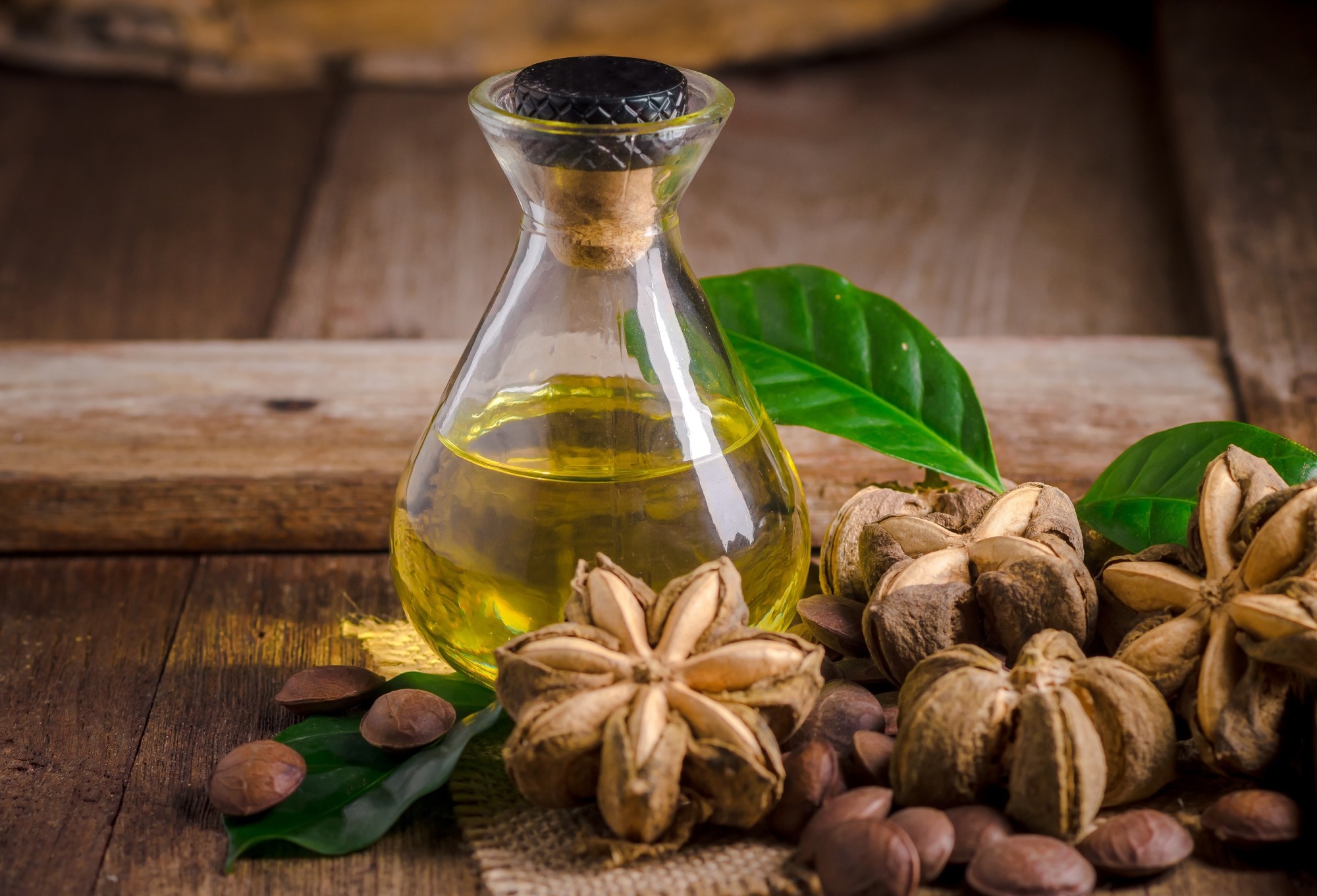Inside the Inca peanut: Fatty acids, proteins, and polyphenols
Cholesterol, inflammation, and vascular protection
Improving glycemic control and insulin sensitivity
Comparative insights from humans and animal models
Safety and dosage considerations
Future directions
Conclusions
References
Further reading
Sacha inchi is a nutrient-rich Amazonian oilseed high in omega-3 fatty acids, proteins, and antioxidants that supports lipid balance, glycemic control, and vascular health. Current evidence suggests promising cardiometabolic benefits, though larger human trials are still needed.
 Image Credit: Kaiskynet Studio / Shutterstock.com
Image Credit: Kaiskynet Studio / Shutterstock.com
Sacha inchi (Plukenetia volubilis), often called the ‘Inca peanut,’ is a perennial oilseed native to Peru and northwestern Brazil. This article reviews the omega-3-rich profile and cardiometabolic benefits associated with sacha inchi consumption while highlighting lipid effects, safety, intake guidance, and research gaps.1,2
Inside the Inca peanut: Fatty acids, proteins, and polyphenols
Sacha inchi seeds contain about 35–60% lipids and 25–33% protein. Their fatty acid profile includes α-linolenic acid (ALA) at 47–51%, linoleic acid (LA) at 34–37%, and oleic acid at ~9–10%. Polyunsaturated fatty acids can comprise up to 93% of total fatty acids. Seeds are also rich in vitamin E, especially γ- and δ-tocopherols, along with phenolics, lignans, and phytosterols. This yields a favorable omega-3 to omega-6 balance compared to other oilseeds.1,2
The ALA fraction of sacha inchi oil is significantly higher than that of palm, corn, soy, and sunflower oils, making it one of the most ALA-dense plant oils available.2
Cholesterol, inflammation, and vascular protection
In both hypercholesterolemic and healthy adults, daily sacha inchi oil intake (10–15 mL/day for 16 weeks) reduced total and low-density lipoprotein cholesterol (LDL-C) and increased high-density lipoprotein cholesterol (HDL-C). Postprandially, the incorporation of sacha inchi oil into a high-fat meal reduced IL-6 levels in metabolically healthy men, though in metabolically unhealthy men only IL-6 was reduced.3
Mechanisms include improved endothelial nitric oxide synthase (eNOS) activity, enhanced nitric oxide (NO) bioavailability, and reductions in oxidative stress markers such as malondialdehyde (MDA) and advanced oxidation protein products (AOPPs). Additional pathways include non-competitive inhibition of HMG-CoA reductase and cholesterol esterase by nutshell extracts, suggesting possible complementary lipid-lowering effects.3
Improving glycemic control and insulin sensitivity
In a rat model of type 2 diabetes (high-fat diet/streptozotocin), sacha inchi oil (0.5–2 mL/kg b.w.) reduced fasting glucose and improved insulin resistance in a dose-dependent manner. Improvements included increased hepatic glycogen storage, upregulation of insulin receptor substrate-1 and phosphorylated Akt, and downregulation of gluconeogenic enzymes. Antioxidant defenses were enhanced via superoxide dismutase, catalase, and glutathione peroxidase, with reduced MDA and pro-inflammatory cytokines (TNF-α, IL-6).4
A randomized trial in humans also reported improved post-prandial insulin sensitivity after oil intake. For weight management, the protein-rich seeds and unsaturated-fat profile may support satiety, while obesity models demonstrate reduced inflammation and oxidative stress.3,4
Comparative insights from humans and animal models
Human and preclinical studies support cardiometabolic benefits. In adults, supplementation with sacha inchi oil lowered blood pressure and improved lipid markers.3 Meal challenge studies show postprandial cholesterol and IL-6 reductions in metabolically healthy men. In rodent models, oil intake consistently reduced total cholesterol, triglycerides, and LDL-C, while raising HDL-C. Sacha inchi also influenced gut microbiota and bile acid metabolism, supporting lipid regulation.3,4
In diabetic rats, supplementation improved insulin sensitivity and attenuated hepatic steatosis. Despite these findings, clinical data remain limited and short in duration, underscoring the need for larger randomized controlled trials.3,4
Safety and dosage considerations
Human trials report good acceptability at 10–15 mL/day of oil or ~30 g/day roasted seeds. These intakes improved lipid profiles without significant adverse effects.1,3 Roasting reduces antinutrients and enhances antioxidant activity, making it the traditional preparation method.1
At very high intakes, especially of raw seeds or concentrated oil, toxicity risks have been reported in animal studies.1
Sacha inchi seeds are traditionally roasted, as thermal processing reduces antinutrients and enhances antioxidant capacity to support sensory acceptance. In individuals with cardiovascular or metabolic conditions, sacha inchi has been studied as a functional food for cardiometabolic control and hypocholesterolemic effects, complementing standard diets.1,3
Overall, existing trials support prudent daily use within studied ranges, with attention to tolerance and preparation.1
 Image Credit: Anda Audy / Shutterstock.com
Image Credit: Anda Audy / Shutterstock.com
Future directions
Evidence for cardiometabolic benefits is promising but preliminary. Larger, longer-term clinical trials are needed to establish efficacy, safety, and optimal dosing. Future research should also explore gut microbiome interactions, potential food–drug interactions, and co-fortification strategies (e.g., dairy enrichment with omega-3 oils). Novel technologies such as microencapsulation may improve oxidative stability and bioavailability, enabling incorporation into functional foods.2,3
Conclusions
Human and animal studies indicate sacha inchi can improve lipid profiles, glycemic control, and inflammatory markers. The rich composition of ALA, tocopherols, proteins, and polyphenols likely underpins these effects. As part of balanced diets emphasizing plant-based unsaturated fats, sacha inchi oil and seeds may support cardiometabolic health, though confirmation in large RCTs is still needed.1–4
References
- Rodzi, N. A. R. M., & Lee, L. K. (2022). Sacha Inchi (Plukenetia Volubilis L.): recent insight on phytochemistry, pharmacology, organoleptic, safety and toxicity perspectives. Heliyon 8(9). DOI:10.1016/j.heliyon.2022.e10572, https://www.cell.com/heliyon/fulltext/S2405-8440(22)01860-6
- Cárdenas, D. M., Gómez Rave, L. J., & Soto, J. A. (2021). Biological Activity of Sacha Inchi (Plukenetia volubilis Linneo) and Potential Uses in Human Health: A Review. Food Technology & Biotechnology 59(3), 253-266. DOI:10.17113/ftb.59.03.21.6683, https://www.ftb.com.hr/archives/1722-biological-activity-of-sacha-inchi-plukenetia-volubilis-linneo-and-potential-uses-in-human-health-a-review
- Abd Rahman, I. Z., Nor Hisam, N. S., Aminuddin, A., et al. (2023). Evaluating the Potential of Plukenetia volubilis Linneo (Sacha Inchi) in Alleviating Cardiovascular Disease Risk Factors: A Mini Review. Pharmaceuticals 16(11). DOI:10.3390/ph16111588, https://www.mdpi.com/1424-8247/16/11/1588
- Rojanaverawong, W., Wongmanee, N., & Hanchang, W. (2023). Sacha inchi (Plukenetia volubilis L.) oil improves hepatic insulin sensitivity and glucose metabolism through insulin signaling pathway in a rat model of type 2 diabetes. Preventive Nutrition and Food Science 28(1), 30-40. DOI:10.3746/pnf.2023.28.1.30, https://www.pnfs.or.kr/journal/view.html?doi=10.3746/pnf.2023.28.1.30
Further Reading
Last Updated: Sep 9, 2025